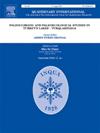Study on the spatial and temporal distribution of Shell Midden sites in China and their relationship with climate and environment
IF 1.8
3区 地球科学
Q3 GEOGRAPHY, PHYSICAL
引用次数: 0
Abstract
Shell midden sites, archaeological deposits dominated by mollusk remains, serve as critical archives for reconstructing aquatic resource exploitation and human-environment dynamics. Since their 19th-century discovery in Southeast Asia, interdisciplinary approaches (typological, zooarchaeological, and environmental analyses) have established their significance in deciphering prehistoric subsistence patterns and past environmental changes. Shell midden sites are mainly distributed in coastal and riverine-lacustrine areas, with shellfish species categorized as marine or freshwater. The chronological framework of shell midden sites is as follows: during the Late Paleolithic period (approximately 25,000–10,000 yr BP), shell midden sites appeared in inland areas; in the Early to Middle Neolithic period (approximately 9000–5000 yr BP), following the end of the Last Glacial Maximum (LGM, approximately 26,500–19,000 yr BP), marine shell midden sites proliferated in coastal areas. The peak of shell midden sites occurred during the Holocene Climatic Optimum (approximately 8000–5000 yr BP), with climate change, the development of agriculture, and other factors, shell midden sites gradually declined, continuing into the Late Bronze Age (approximately 5000–3000 yr BP). Although previous studies have revealed that climate change, sea-level fluctuations, and shifts in human subsistence strategies contributed to these changes, a comprehensive understanding of when and why shellfish began and ceased to be a primary food source is still lacking. This study analyzes the spatio-temporal distribution of shell midden sites over China and explores how climate and sea-level changes influenced the initiation and cessation of shellfish consumption as a main food source. The findings indicate that climate and sea-level fluctuations significantly affected the distribution of shellfish resources, thus influencing ancient human subsistence strategies and driving the transition to agricultural and pastoral economies. Changes in subsistence strategies accelerated the decline of shell midden sites.

中国壳牌米登基地的时空分布及其与气候环境的关系研究
贝壳堆遗址是以软体动物遗骸为主的考古沉积物,是重建水生资源开发和人类环境动态的重要档案。自从19世纪它们在东南亚被发现以来,跨学科的方法(类型学、动物考古学和环境分析)已经确立了它们在破译史前生存模式和过去环境变化方面的重要意义。贝壳中点主要分布在沿海和河湖地区,贝类种类分为海洋和淡水两类。旧石器时代晚期(约25000 - 10000年),贝壳堆遗址出现在内陆地区;在新石器时代早期至中期(约9000-5000年),末次盛冰期(LGM,约26500 - 19000年)结束后,沿海地区的海洋贝壳堆遗址激增。在全新世气候最佳期(约8000 ~ 5000 yr BP),贝壳堆遗址数量达到高峰,随着气候变化、农业发展等因素的影响,贝壳堆遗址数量逐渐减少,并持续到青铜时代晚期(约5000 ~ 3000 yr BP)。尽管先前的研究表明,气候变化、海平面波动和人类生存策略的转变促成了这些变化,但对贝类何时以及为何开始和停止成为主要食物来源的全面理解仍然缺乏。本研究分析了中国贝类中采点的时空分布,探讨了气候和海平面变化对贝类作为主要食物来源的消费开始和停止的影响。研究结果表明,气候和海平面波动显著影响了贝类资源的分布,从而影响了古代人类的生存策略,推动了向农牧经济的过渡。生存策略的变化加速了贝壳堆积点的减少。
本文章由计算机程序翻译,如有差异,请以英文原文为准。
求助全文
约1分钟内获得全文
求助全文
来源期刊

Quaternary International
地学-地球科学综合
CiteScore
5.60
自引率
4.50%
发文量
336
审稿时长
3 months
期刊介绍:
Quaternary International is the official journal of the International Union for Quaternary Research. The objectives are to publish a high quality scientific journal under the auspices of the premier Quaternary association that reflects the interdisciplinary nature of INQUA and records recent advances in Quaternary science that appeal to a wide audience.
This series will encompass all the full spectrum of the physical and natural sciences that are commonly employed in solving Quaternary problems. The policy is to publish peer refereed collected research papers from symposia, workshops and meetings sponsored by INQUA. In addition, other organizations may request publication of their collected works pertaining to the Quaternary.
 求助内容:
求助内容: 应助结果提醒方式:
应助结果提醒方式:


